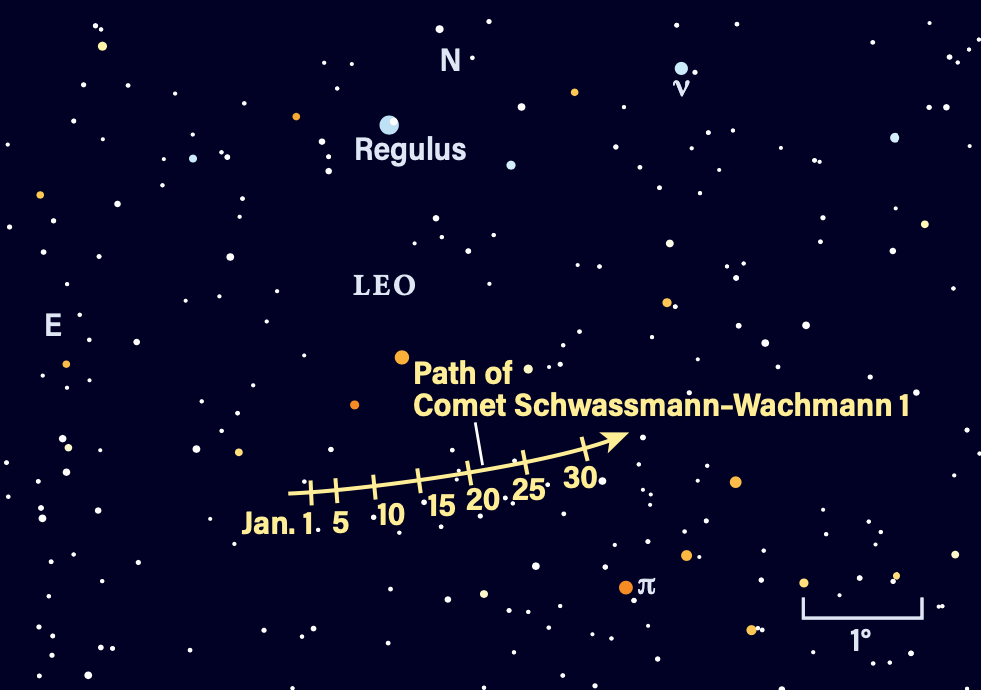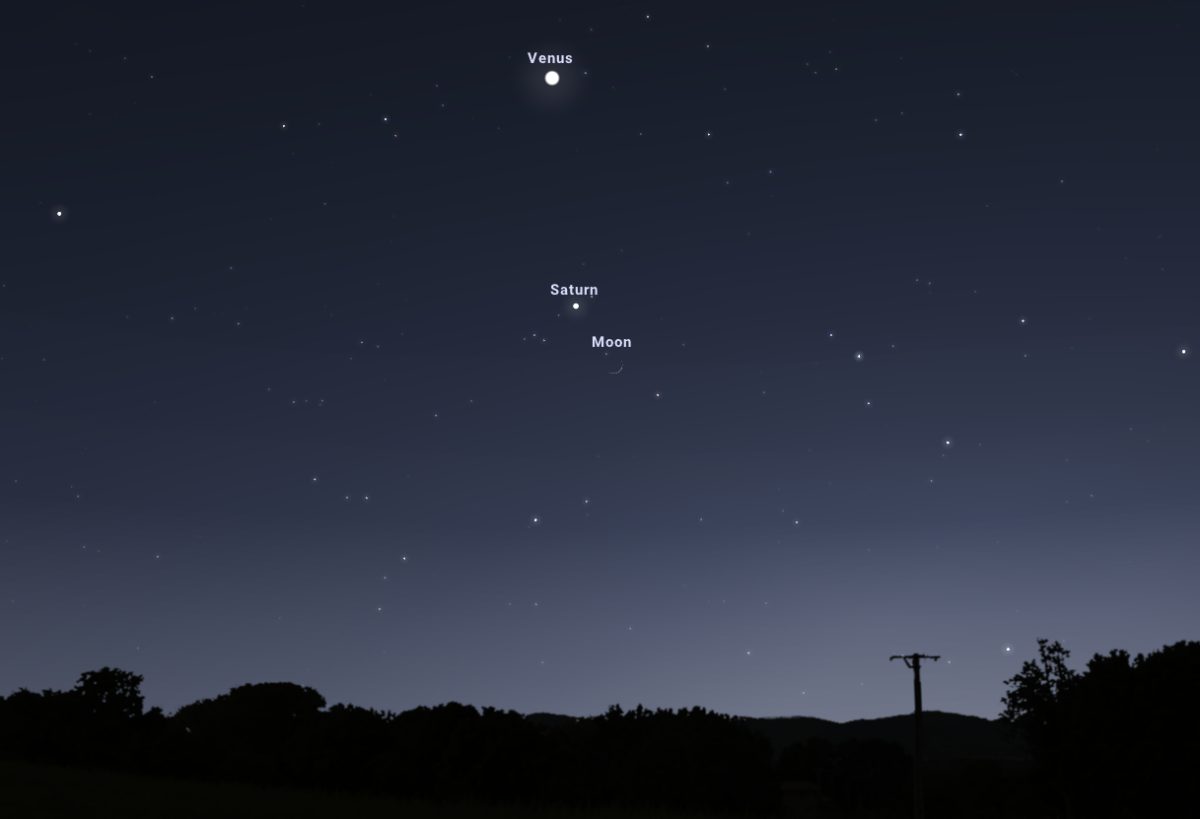Friday, January 24The Moon passes 0.3° south of the intense purple massive famous person Antares at 7 P.M. EST. Then again, the pair isn’t visual this night, as they’ll upward thrust within the early-morning sky, so we’ll characteristic them the next day.
This night, we’ll focal point as a substitute on Mars. The Pink Planet just lately reached opposition and remains to be visual necessarily all night time lengthy, shining at magnitude –1.3 in Gemini close to the constellation’s beta famous person, Pollux.
Via a telescope, Mars’ disk spans 14”, permitting observers with just right seeing and big telescopes to make out a few of its maximum outstanding floor options. Round 9 P.M. native time within the mid-U.S., the darkish equatorial characteristic Syrtis Main and brighter Hellas basin within the southern hemisphere are kind of central at the disk. For those who continue to exist the East Coast, you’ll see those options centrally at 10 P.M. EST; in case you are living west of the Central time zone, glance an hour or two previous. Watch the planet in a single day, and you could catch the Tharsis area and big Olympus Mons beginning to rotate onto the disk simply as crack of dawn is starting to wash out your view.
Because of its rather longer day than Earth’s, Mars seems to rotate backwards when considered on the similar time every night time. Give the planet a couple of extra nights, and within the final week of the month, the darkish Mare Cimmerium can be visual at the central disk round 9 P.M. native time.
First light: 7:15 A.M.Sundown: 5:10 P.M.Moonrise: 3:15 A.M.Moonset: 12:22 P.M. Moon Segment: Waning crescent (24%)*Instances for dawn, sundown, moonrise, and moonset are given in native time from 40° N 90° W. The Moon’s illumination is given at 12 P.M. native time from the similar location.
Saturday, January 25Now let’s meet up with the Moon and Antares, which each in any case breach the horizon via about 4:30 A.M. native time. Notice that the Moon is now a skinny crescent simply 18 % lit, situated some 6° to the decrease left of magnitude 1.1 Antares.
They’re within the constellation Scorpius, which rises slowly and doesn’t get very top prior to crack of dawn breaks. The brilliant Moon will stay visual into the morning — chances are you’ll even catch some earthshine lights up its darkened face, as daylight bounces off Earth to forged slightly of sunshine at the portion of the Moon that lies in our planet’s shadow. Quickly, all of our Moon will lie in Earth’s shadow, as our satellite tv for pc reaches New segment later this week.
As a reasonably shiny famous person, Antares must stay visual because the sky lightens as neatly, regardless that it’s going to in the end wink out because the background mild overwhelms it. This purple massive bears a visible resemblance to the planet Mars because of its colour, however in fact is a groovy, ageing famous person tens of hundreds of occasions brighter than our Solar and a few 15 to 18 occasions extra large. It’s going to at some point finish its existence in a supernova explosion, quickly flaring into an excellent brighter level of sunshine prior to fading absolutely from view.
First light: 7:14 A.M.Sundown: 5:11 P.M.Moonrise: 4:19 A.M.Moonset: 1:06 P.M. Moon Segment: Waning crescent (16%)
 Comet 29P/Schwassmann–Wachmann, often known as Schwassmann–Wachmann 1, might greet the brand new 12 months with an outburst in Leo. M105, NGC 3384, and NGC 3389 lie east of this box of view. Credit score: Astronomy: Roen Kelly
Comet 29P/Schwassmann–Wachmann, often known as Schwassmann–Wachmann 1, might greet the brand new 12 months with an outburst in Leo. M105, NGC 3384, and NGC 3389 lie east of this box of view. Credit score: Astronomy: Roen Kelly
Sunday, January 26With no moonlight within the night sky and chilly wintry weather air providing reasonably strong perspectives, this night is a smart alternative to check out monitoring down a faint comet: Comet 29P/Schwassmann–Wachmann, often known as Schwassmann–Wachmann 1.
Now making its manner via Leo, Schwassmann–Wachmann 1 is kind of twelfth magnitude, striking it in vary of bigger scopes and extra skilled observers. Thankfully, it’s close to a shiny famous person, slightly below 3.5° southwest of magnitude 1.4 Regulus in Leo the Lion. Emerging round 7 P.M. native time, wait a couple of hours for this area to climb upper within the east prior to attempting your success. The later within the the night time you follow, the upper Leo will stand, providing clearer, much less turbulent air to help your seek.
Schwassmann–Wachmann 1 must seem as a faintly sparkling “fuzzball” about an arcminute throughout. There’s a probability it might be in outburst and rather brighter than anticipated, round Tenth or eleventh magnitude. Check out magnifications of 150x or extra and be affected person, giving your eyes time to regulate and the usage of avoided imaginative and prescient to cause the light-sensitive rods to your eyes.
First light: 7:13 A.M.Sundown: 5:13 P.M.Moonrise: 5:20 A.M.Moonset: 2:01 P.M. Moon Segment: Waning crescent (9%)
Monday, January 27Already 50° top within the east at sundown within the constellation Taurus, the intense planet Jupiter is straightforward to identify, shining at magnitude –2.6 to the higher proper of the famous person Aldebaran. The planet’s presence provides Taurus the semblance of 2 eyes, slightly than its feature one.
Zoom in on that higher “eye” with a telescope to view Jupiter’s 44”-wide disk. East Coast observers, chances are you’ll catch the beginning of a transit as the huge moon Ganymede starts crossing the southern portion of the disk simply after 5 P.M. EST; the ones farther west will see the transit already underway at sundown. Kind of two and a part hours later, round 7:20 P.M. EST, the transit ends because the moon slips clear of the southwestern limb.
Ganymede’s massive shadow joins in as neatly, regardless that there’s slightly of a wait. The darkish blot in any case seems at the cloud tops on the planet’s southeastern limb 9:40 P.M. EST, with Ganymede just about 30” from the southwestern limb. The shadow takes simply over two hours to go at the back of the moon, finishing its transit simply prior to the stroke of middle of the night within the jap U.S., at 11:59 P.M. EST.
And whilst you’re staring at Ganymede and its shadow put at the major display, don’t fail to remember to look east of the planet to identify Europa, or west to peer Io and Callisto, with the previous nearer to the planet than the latter.
First light: 7:13 A.M.Sundown: 5:14 P.M.Moonrise: 6:13 A.M.Moonset: 3:05 P.M. Moon Segment: Waning crescent (4%)
Tuesday, January 28Blazing Venus is a shiny night famous person shining at magnitude –4.7 within the sky after sundown. An hour after the Solar is going down, Venus hangs 30° above the southwestern horizon, at once above magnitude 1.1 Saturn. The latter planet is in Aquarius, however Venus is in southwestern Pisces, nearing the magnitude 4.5 famous person Lambda (λ) Piscium, certainly one of seven stars that shape the Circlet asterism.
Venus is now slightly below 3° south-southwest of Lambda, and can proceed final in over the following couple of days. By the point January involves an in depth, the planet will take a seat simply 1.5° from the famous person.
Via a telescope, Venus seems some 41 % lit and spans an outstanding 30”. Evaluate that to Saturn, whose disk is 16” throughout — regardless that in fact, the fuel massive is bodily a lot better than Venus. Saturn’s higher distance from Earth — some 10.4 astronomical gadgets, as opposed to Venus’ distance of 0.6 astronomical unit — is the explanation apparently such a lot smaller. (One astronomical unit, or AU, is the common Earth-Solar distance of 93 million miles (150 million kilometers.)
However Saturn’s rings give it some further width, stretching 36” from finish to finish. They’re now tilted about 3° towards Earth from our perspective, providing a reasonably skinny profile via your telescope. In March, sadly after the planet disappears into the glare of the Solar, they’ll seem completely edge-on, an tournament referred to as a ring-plane crossing.
Invisible and not using a telescope or binoculars is an much more far away global: Neptune. It sits 4° east of Venus this night and can characteristic in our access for the next day.
First light: 7:12 A.M.Sundown: 5:15 P.M.Moonrise: 6:59 A.M.Moonset: 4:17 P.M. Moon Segment: Waning crescent (1%)
Wednesday, January 29New Moon happens at 7:36 A.M. EST this morning.
Let’s go back to Pisces this night to concentrate on the sun machine’s maximum far away planet, Neptune, which shines at magnitude 7.8, beneath the naked-eye threshold. That implies you’ll want both binoculars or a telescope to find it, status 1° due north of the Sixth-magnitude famous person 24 Psc this night (and final a identical distance from the famous person for the following couple of nights as neatly).
A far brighter signpost to discovering Neptune is, after all, magnitude –4.7 Venus, the brightest level of sunshine within the sky. Neptune lies about 3.5° southeast of Venus this night — a testomony to how temporarily the latter planet is transferring via our sky, because of its proximity. Neptune, in the meantime, is so far away that apparently to shift best slowly relative to the background, and its disk spans simply 2” — some 1/15 the scale of Venus’.
To spot Neptune, search for a small, “flat” famous person with a bluish or grayish hue to your eyepiece. This night, Neptune lies greater than 30 AU from Earth — just about thrice the gap of Saturn.
First light: 7:11 A.M.Sundown: 5:16 P.M.Moonrise: 7:37 A.M.Moonset: 5:32 P.M. Moon Segment: New
Thursday, January 30Another far away planet is in our points of interest this night, as Uranus stands desk bound at 2 P.M. EST.
Uranus lies in a ways jap Aries, within the southeastern sky after sundown. As soon as the sky grows darkish, search for the Pleiades famous person cluster (M45) in western Taurus — this shiny, well-known deep-sky object can also be your information. Uranus is situated to the cluster’s decrease proper, about 8° southwest of M45. Whenever you’re getting shut, simply drop 3° south of Fifth-magnitude Tau (τ) Arietis.
Uranus glows at magnitude 5.7, proper at the fringe of what the bare eye can see. One of the best ways to seek out it’s the usage of binoculars or a telescope, as both will readily pick out up the faint planet. Uranus is a few 19.3 AU from Earth and looks about two times as massive as Neptune within the sky, spanning some 4”. Like on the lookout for Neptune, stay an eye fixed out for a “flat” famous person that looks extra like a tiny disk than a pinprick of sunshine. Uranus additionally has a tendency to have a lifeless grayish hue, slightly than the piercing blue, white, or orangey-red of a celebrity.
First light: 7:10 A.M.Sundown: 5:17 P.M.Moonrise: 8:08 A.M.Moonset: 6:48 P.M. Moon Segment: Waxing crescent (2%)
 Venus, Saturn, and the Moon create a phenomenal image within the night sky at the thirty first. Credit score: Stellarium/Noctua Device, Panorama pictures via Fabien Chereau
Venus, Saturn, and the Moon create a phenomenal image within the night sky at the thirty first. Credit score: Stellarium/Noctua Device, Panorama pictures via Fabien Chereau
Friday, January 31A subtle crescent Moon mingles with Saturn within the night sky, passing 1.1° north of the ringed planet at nighttime EST.
Previous within the night, say an hour after sundown, the 2 are about 3° aside and a few 20° top within the west. They’re placing underneath the intense planet Venus, growing an exquisite setup for astrophotos — specifically if you’ll in finding a captivating panorama to position underneath them. Saturn remains to be 1st magnitude, making it the second-brightest level of sunshine on this area of the sky, after Venus. The Moon is now simply 2.5 days outdated, with some 8 % of its face in daylight.
That crescent Moon additionally way Saturn must be simply visual via a telescope with out a lot background mild interfering. This night, the planet’s largest and brightest moon, Titan, is situated about 30” away, to Saturn’s northeast. The mid-Eighth-magnitude moon must be visual in binoculars or a telescope as neatly, even though fainter moons could also be tougher to make out, equivalent to Tenth-magnitude Dione, Rhea, and Tethys. The latter is situated simply south of the rings on this planet’s jap aspect previous within the night, then transits beginning round 7:20 P.M. MST (after Saturn has set for the jap part of the rustic). Dione and Rhea are each neatly to the west of the planet, with the previous nearer than the latter.
First light: 7:09 A.M.Sundown: 5:19 P.M.Moonrise: 8:35 A.M.Moonset: 8:02 P.M. Moon Segment: Waxing crescent (6%)

Sky This Week is delivered to you partly via Celestron.

